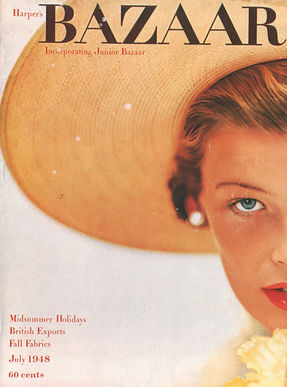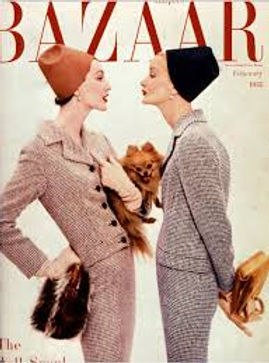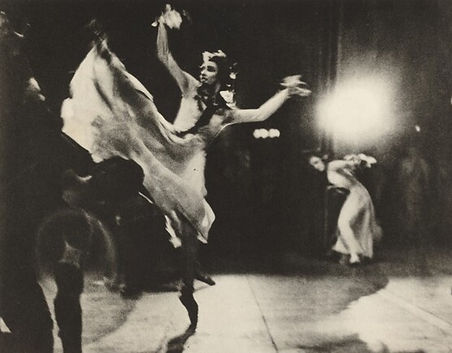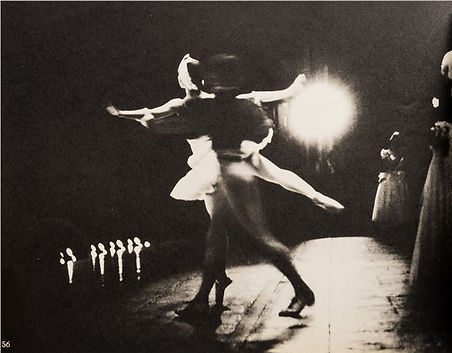
Alexey Brodovitch
Astonish me
Alexey Brodovitch
Who was Alexey Brodovitch?
Alexey Brodovitch was one of the pioneers of modern graphic design. Born in Russia, trained in France, he made graphic design history when he became art director of Harper's Bazaar in New York, where he transformed the magazine's aesthetic for over two decades. With his radically new approach to layout, typography and image, Brodovitch imposed a visual language that would have a lasting influence on the press, photography and advertising. He collaborated with some of the greatest names of his time, including Richard Avedon, Man Ray and Henri Cartier-Bresson, and passed on his vision through a discreet but seminal teaching style.
Biography
The man who made the pages dance.
Alexey Brodovitch was born in 1898 in a region between St. Petersburg and the Finnish border, into a wealthy, cultured Russian family. His father, a doctor, would later run a psychiatric hospital in Moscow, while his mother, an amateur artist, instilled in him a love of painting. In 1905, the family moved to the capital, and Alexey continued his studies in Saint Petersburg.
But the war turned his life upside down. In 1914, he abandoned his plans to study art and entered a military school. A cavalry officer during the Civil War, he was wounded in Odessa in 1918. Like many exiles fleeing the rise of Bolshevism, he left Russia and, after a long journey through the Caucasus and Turkey, arrived in Paris in 1920 with his future wife, Nina.
The Paris years: between decor and modernity
In Paris, Brodovitch turned to the decorative arts. He worked for Diaghilev's Ballets Russes, collaborated with the magazines Arts et Métiers Graphiques and Cahiers d'Art, designed sets and menus for the Prunier restaurant, and signed several noteworthy posters. In 1928, he became artistic director of the department store Aux Trois Quartiers, where he designed windows, interiors and advertising.
His style was already characterized by a modern approach, influenced by Russian Constructivism and the Bauhaus. In 1930, the writer Philippe Soupault devoted a remarkable article to him. This recognition opened the door to America.
America: avant-garde laboratory
Settled in the United States in 1930, Brodovitch taught advertising graphics at the Pennsylvania Museum School of Industrial Arts, where he founded an innovative workshop: the Design Laboratory. This place of experimentation became a crucible of new ideas, and Brodovitch passed on his passion for research, creative instinct and interdisciplinary dialogue.
It was in 1934 that his career took a decisive turn: Carmel Snow, editor-in-chief of Harper's Bazaar magazine, entrusted him with the magazine's artistic direction. Brodovitch imposed a revolutionary style: asymmetrical compositions, bold white space, dynamic typography and full-page photography. He brought modernity to the fashion press.
He collaborated with the greatest names in photography: Man Ray, Martin Munkacsi, George Hoyningen-Huene, and revealed talents such as Richard Avedon, Irving Penn and Hiro. He also invited the Europeans Cartier-Bresson, Brassai, Kertész, Lisette Model and Maurice Tabard, whom he had met in Paris. For Brodovitch, photography should not illustrate, but tell, suggest and disturb.
Ballet, Observations and the art of the book
In parallel with his publishing work, Brodovitch developed a personal photographic oeuvre. In 1945, he published Ballet, a rare and visionary book based on photographs taken ten years earlier during a Ballets Russes tour of the United States. The style is unique: deliberate blurring, deep black, no captions - a visual choreography, intimate and abstract.
He also designed the layout for the legendary Observations (1959), a book by Richard Avedon with a text by Truman Capote, considered one of the pinnacles of photographic publishing. He also worked on books by Martin Munkacsi, André Kertész and Hoyningen-Huene.
His most ambitious project was the short-lived but influential magazine Portfolio, which produced just three issues between 1950 and 1951.
The end of a cycle and a silent legacy
In 1958, Brodovitch left Harper's Bazaar. In 1966, he retired to Le Thor in the south of France. Ill and withdrawn from the world, he died in 1971 to relative indifference.
But his legacy is immense. He redefined the role of the art director, trained generations of artists, and profoundly marked the history of graphic design, publishing and photography. In 1982, a tribute exhibition was held in Arles and Paris. Other retrospectives followed in the United States, notably at the Cooper Union in 1994.
Today, the Wallace Memorial Library at the Rochester Institute of Technology houses part of his archive. His influence lives on: in every daring layout, every photograph that captures the moment, every creator who dares to experiment, we can still hear his famous motto:
“Astonish me.”
Harper’s Bazaar
When Alexey Brodovitch joined Harper's Bazaar in 1934, he transformed a fashion magazine into a work of editorial design. He introduced a dynamic layout, playing on movement, white space and bold typography, breaking with the rigid conventions of the time.
Under his direction, photography became central, fluid and sometimes provocative - revealing talents such as Richard Avedon and Henri Cartier-Bresson. Brodovitch doesn't just format: he orchestrates. He creates a visual language in which each page is conceived as a scene.
For over twenty years, he imposed a refined, avant-garde aesthetic, making Harper's Bazaar a global benchmark for graphic design.
His demand was summed up in two words: “Astonish me." And he succeeded, relentlessly.









Designer
Alexey Brodovitch has never separated content from form. His work as a designer continues the same obsessions that run through his layouts: fluidity, balance, the invisible tension between full and empty.
One of the few pieces of his work to have come to public attention is the Floor Chair (model 1211-C), now in the permanent collection of the Museum of Modern Art (MoMA) in New York. Designed in the 1940s, this low chair embodies a radical, silent modernity.
Made entirely of curved plywood, the chair rests directly on the floor, with no visible legs or structure. Two curves fit together with organic precision, forming a single gesture - almost a fold in the material. With no screws or decoration, it seems to have been born in a single stroke, suspended between functional design and minimal sculpture.
More than a piece of furniture, the Floor Chair is an idea made tangible: that of humble comfort, close to the ground, anchored in an aesthetic of sobriety. It reminds us that for Brodovitch, design was an art of rhythm - be it typography, movement or material.

















Photographs
Yet Alexey Brodovitch's photographic work is of a rare intensity. His most emblematic project, Ballet, made in 1945, is unlike anything else being done at the time: blurred, vibrant images, taken without flash, on the fly, in the shadows of rehearsals by Russian troupes in exile.
This blur, far from being a clumsiness, becomes a language. Brodovitch does not seek to freeze movement, but to capture its fleeting memory. His profoundly modern images evoke a sensation rather than a scene. They speak of rhythm, tension and silence. We recognize in them the eye of the graphic artist - one who knows how to compose, balance and suggest - but also a deep visual melancholy.
Ballet was only published in a limited, confidential edition. Even today, this book is considered a discreet masterpiece, a precursor of emotional reportage and experimental photography.
Brodovitch's aim as a photographer was not to document, but to make people feel.









The rebirth of a forgotten heritage
In the hushed silence of a light-filled villa in the south of France, a forgotten treasure has resurfaced. There, among the personal effects of Alexey Brodovitch, an iconic figure of twentieth-century visual elegance, his descendants have rediscovered an unpublished series of plans, sketches and notes: fragments of a visionary work that remained in the shadows - the furniture he never had time to bring into existence.
Carefully preserved, these documents reveal a strikingly modern formal language: pure lines, bold proportions, a subtle balance between functionality and beauty. Each piece of furniture designed by Brodovitch seems to translate, in volume and material, the same sophistication as his graphic compositions for Harper's Bazaar.
Supported by his descendants, this renaissance now takes the form of a unique project. Each piece of furniture will be produced in a limited series, using exceptional craftsmanship, noble materials and impeccable finishes. This is not a reinterpretation, but a revelation: the bringing into the world of objects designed by a master, and kept secret for too long.
More than a collection, it's a manifesto. A rare encounter between heritage and creation, between intimate memory and contemporary demands. For aesthetes, collectors and design enthusiasts, it's a unique opportunity to own an authentic fragment of the Brodovitch universe - tangible, rare, essential. This project will soon see the light of day, and you won't be disappointed.